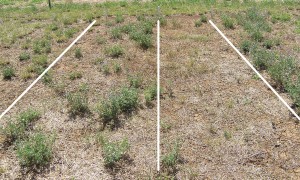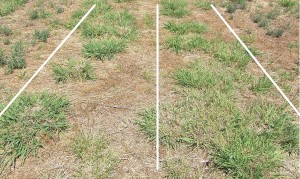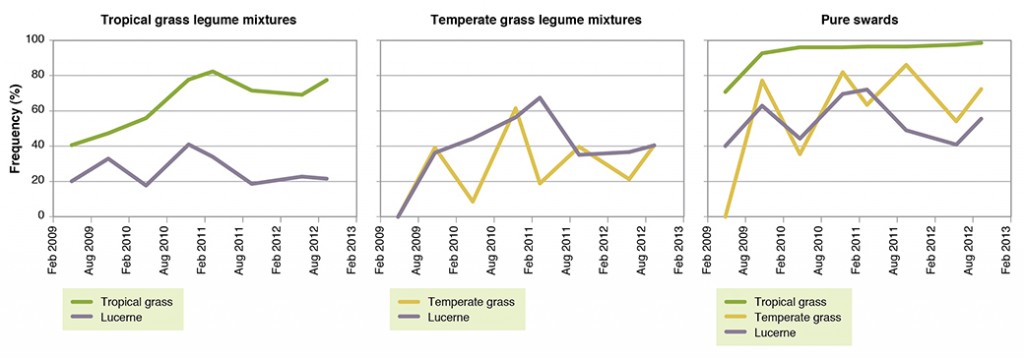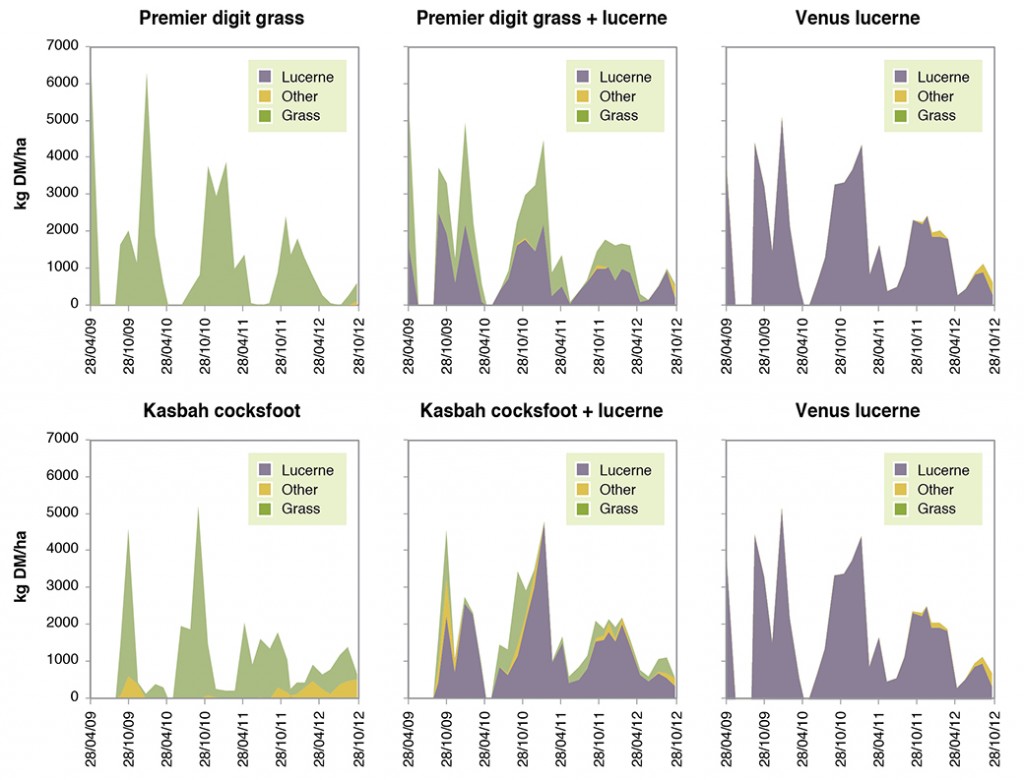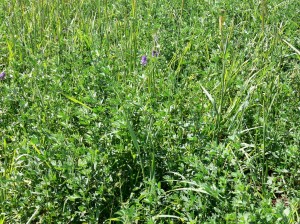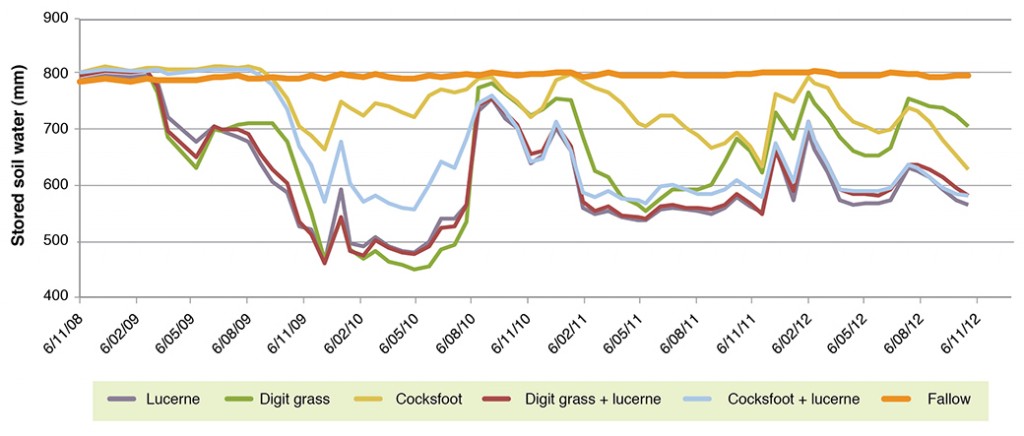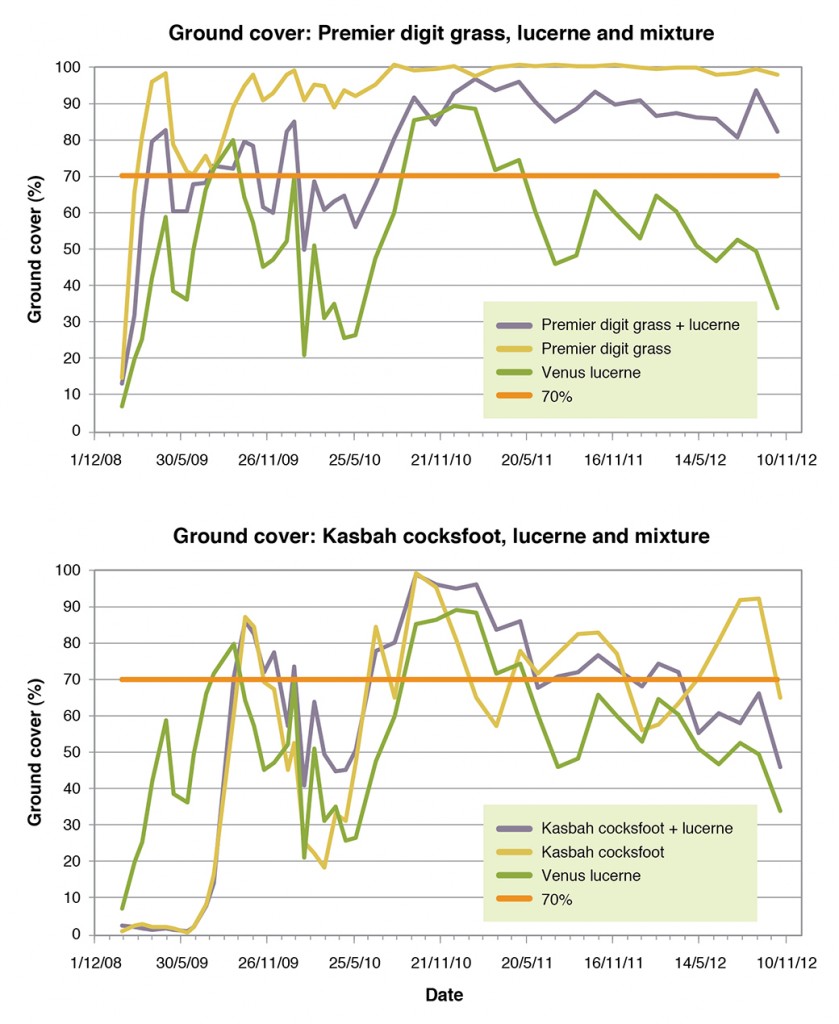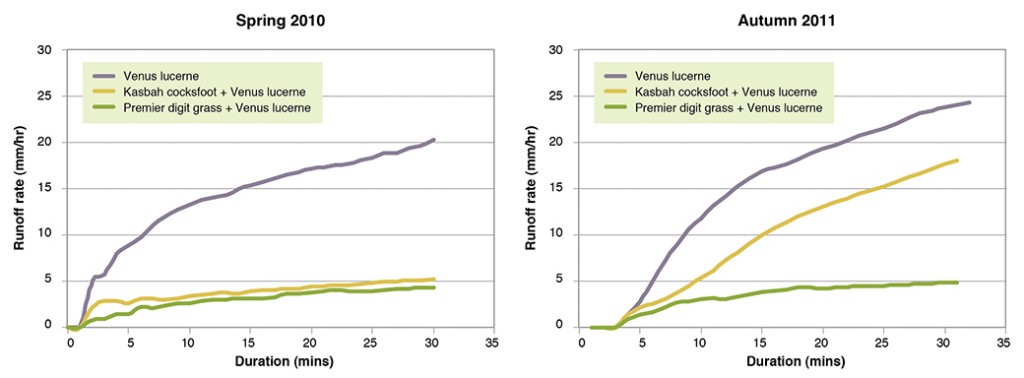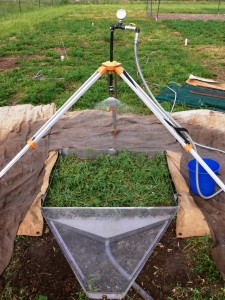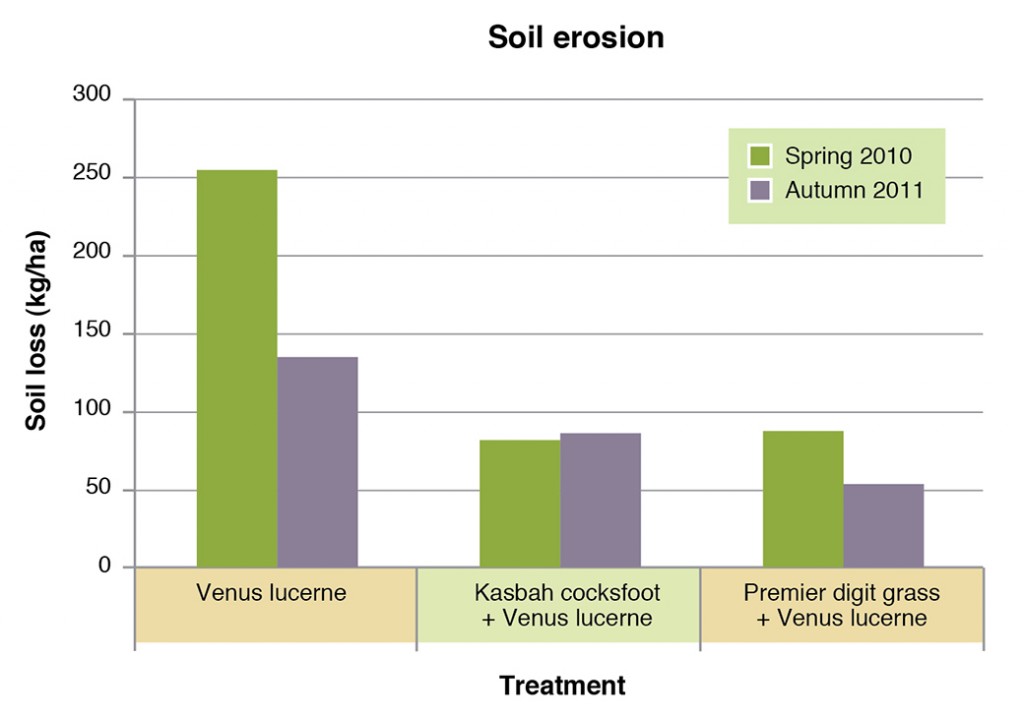Lucerne-grass mixtures outperform pure grass pastures on the North West Slopes of NSW
Pastures with a mixture of lucerne and tropical perennial grass have potential to increase total dry matter production and spread its distribution more evenly through the year, thereby reducing feed gaps and providing greater resilience in variable seasons, while helping to conserve natural resources on farm.
Key findings
Sowing method and persistence of lucerne-grass mixtures
- Lucerne established and persisted (over three years) when grown with tropical grass (digit grass).
- Herbage production of digit grass was similar irrespective of the lucerne sowing rate, indicating that total production increased with lucerne sowing rate (0.5 to 2.0 kg/ha).
- Row configuration (either alternate 1:1 or 1:2 rows) did not affect either herbage production or persistence.
- Sowing lucerne in spring resulted in poor establishment, and sowing digit grass in autumn resulted in low plant density.
- When species in a mixture were sown in split sowings at different times, lucerne dominated autumn sowings and digit grass dominated spring sowings.
Dry matter production
- A lucerne-grass mixture grew similar herbage mass to pure lucerne over three years and more than grasses alone.
- Herbage mass of digit grass was similar in mixture with lucerne irrespective of the lucerne sowing rates tested.
Natural resource management
- Two different lucerne-grass mixtures developed patterns of soil water extraction over time that were similar to pure lucerne alone.
- Two lucerne-grass mixtures had higher ground cover throughout the year compared to lucerne alone, which did not meet the benchmark minimum of 70% ground cover most of the time.
- Two lucerne-grass mixtures substantially reduced runoff rate and eroded sediment compared to lucerne alone. A mixture with tropical grass offered greater protection than did a mixture with temperate grass.
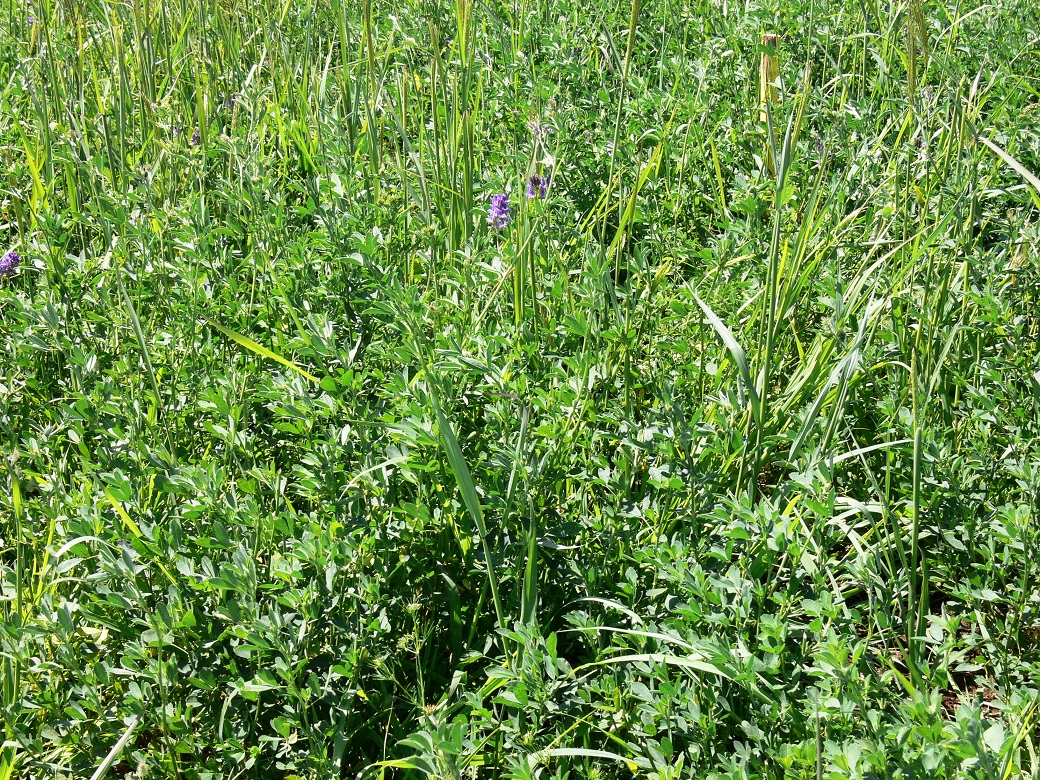
Read more about this research
The issue
Graziers on the North West Slopes of NSW who have a forage base dominated by native grasses have adopted two main approaches for increasing stocking rates and providing higher quality feed for breeding and finishing: sowing forage oats in February on late summer rainfall, and sowing improved perennial pastures. High weaning percentages for spring lambing ewes grazing native perennial grass based pastures can be achieved by integrating forage sources such as oats, lucerne or tropical grasses into the forage base, or providing protein and energy supplements at key times. Forage oats provide high quality feed in winter-spring but present issues with low ground cover in summer and a requirement to be sown annually.
Lucerne is the most widely sown and adapted perennial legume in the region, but has fallen from favour in recent years. One reason for lucerne’s decline is its potential when grazed for low ground cover and associated high risk of surface runoff and erosion. Lucerne’s poor performances in variable rainfall years, low growth in winter, and potential for bloat in cattle are also issues.
A lucerne-grass mix has long been held as an attractive pasture option, but producers identified several challenges when they have attempted to establish mixes, including: competition among seedlings; sowing configuration, time and rate; persistence of species; and total herbage production.
Is a lucerne-grass mix an option?
Sowing lucerne in a mixture with a grass has the potential to increase total pasture production and spread its distribution more evenly through the year, thereby reducing feed gaps and providing greater resilience in variable seasons. A lucerne-grass mix also has potential to reduce issues with ground cover and bloat in cattle associated with lucerne-only stands. Little knowledge is available on recommended sowing rate, time and configuration to best establish a productive lucerne-grass mix and with lucerne’s high competitive ability for soil water use, it is not known whether a temperate or tropical grass will best persist and be productive in a mix.
The competitiveness of species in a mixture at establishment may be minimised by separating the species either spatially or sowing at different times. There is a natural tendency towards dynamic equilibrium or co-existence among species in a mixture. This equilibrium may be related to species occupying different ‘niches’ such as growing in different seasons, having different water use patterns, growth habits, rooting depths or nutrient requirements.
An earlier EverGraze study (Boschma et al. 2010) investigated the competitive ability of lucerne in seedling mixtures with temperate and tropical species, in a competition box study grown under ideal conditions. Lucerne was found to be compatible with tall fescue and phalaris, but highly competitive when sown in spring with tropical grasses, which indicated the potential for these mixes. So in this study, field testing was done to refine recommended options for producers.
What was done?
A series of field experiments (Table 1) was conducted on a Brown Vertosol soil at Tamworth Agricultural Institute from Spring 2008 to Spring 2012 to investigate competition among seedlings, sowing (configuration, time and rate), persistence (plant frequency), herbage production, soil water content and water use efficiency, ground cover and control of surface runoff and erosion of lucerne-grass mixes.
Table 1. Descriptions of species sowing rates, configurations and times of year for a series of experiments established at Tamworth Agricultural Institute to study lucerne-grass mixes.
| Experiment | Rates | Configuration | Time of year |
| Sowing rate and row configuration | Genesis lucerne 0.5, 1.0, 2.0 kg/ha | 1:1, 1:2 or mixed in rows | Spring 2008 |
| Premier digit grass 1.0 kg/ha | |||
| Sowing time | Genesis lucerne 1.0 kg/ha | Pure or 1:1 with grass | Spring 2008 or Autumn 2009 |
| Premier digit grass 2.0 kg/ha | Pure or 1:1 with lucerne | Spring 2008 or Autumn 2009 | |
| Herbage mass and water use efficiency and ground cover | Venus lucerne 1.0 kg/ha in mixes, 2.0 kg/ha in pure | Pure or 1:1 with each grass | Spring 2008 with Premier, Autumn 2009 |
| Premier digit grass 1.0 kg/ha in mixes, 2.0 kg/ha in pure | Pure or 1:1 with lucerne | Spring 2008 | |
| Kasbah Cocksfoot 1.0 kg/ha in mixes, 2.0 kg/ha in pure | Pure or 1:1 with lucerne | Autumn 2009 |
Seedling density counts were conducted about four weeks after sowing. Plant persistence was determined using plant frequency (%) estimated in spring and autumn by the presence of live material in 10 x 10 cm squares within a 1 x 1 m grid and herbage mass was estimated using calibrated visual assessment every six weeks. After each herbage mass assessment, the experiments were grazed by sheep whenever possible or defoliated with rotary mowers to a height of 50mm.
The mixes sown were chosen in an attempt to extend the growing season by generating growth from rainfall in both the cool and warm seasons and so reduce the dependence of livestock systems on annual forage crops.
Sowing rate, configuration, and time of year
Sowing rate and row configuration: Lucerne (cv. Genesis) and digit grass (cv. Premier) were sown in November 2008 using a six row cone seeder as single species swards and in mixes consisting of three configurations: alternating rows of lucerne and grass (1:1), one row of lucerne alternating with two rows of grass (1:2) and the two species mixed in all rows (mixed). Lucerne was sown at three rates: 0.5, 1 and 2 kg/ha, and digit at 1 kg/ha. Pasture performance was assessed by measuring plant persistence and total herbage mass produced.
Sowing time of year: Single species swards and mixtures of lucerne (cv. Genesis, 1 kg/ha) and digit grass (cv. Premier, 2 kg/ha) were sown in May and December 2008. Pasture performance was assessed by measuring plant persistence and total herbage mass produced.
Herbage mass production and persistence from mixtures compared with pure swards
Lucerne (cv. Venus, winter activity rating 5), digit grass (cv. Premier, summer active) and cocksfoot (cv. Kasbah, summer dormant) were sown using a sixrow cone seeder as single species swards and in mixtures of alternating rows of lucerne and grass (1:1). Single species swards of lucerne or digit grass were sown at a seeding rate of 2 kg/ha while in mixtures the rate was 1 kg/ha for each species. Cocksfoot was sown at 3 and 1.5 kg/ha for pure swards and mixtures respectively. Herbage mass data was collected at six week intervals and presented graphically to show seasonal distribution of production and proportion of grass and legume. Totals for growing season were tabulated to show overall contributions and proportions of grass and legume. Pasture performance was assessed by measuring plant persistence and total herbage mass produced.
Water use efficiency of pasture mixtures
Soil water content was estimated at three week intervals by using a neutron probe in access tubes installed to 1.9 m depth in each plot. Water use efficiency (WUE, kg DM/ha.mm) is production per unit of rainfall and stored soil water used. Soil water use, rainfall and herbage mass data were used to calculate WUE for dry matter grown in each six week period that pastures were assessed.
Ground cover of mixtures compared with lucerne pastures
The recommended benchmark for minimum ground cover on the North West Slopes of NSW is 70% throughout the year, as this reduces surface runoff and erosion under most rainstorms (Lang 1998). Ground cover (%) of pure swards and mixtures was visually estimated in five quadrats at six week intervals between spring 2009 and spring 2012 and compared with the 70% benchmark. Species persistence was assessed by estimating plant frequency biannually.
Surface runoff control and erosion control by mixtures
Rainfall simulations were performed to compare surface runoff from pure lucerne plots and mixtures with grasses (Figure 12). Simulations were done in spring 2010 and autumn 2011 shortly after plots were grazed by sheep, which had the effect of reducing leaf cover,. A simulated rainstorm of 105 mm/h was applied to plots for 30-min and surface runoff was collected and measured at 1-min intervals. Collected runoff water was analysed for sediment content.
What was found?
What sowing rate and configuration?
Plant frequency of lucerne sown in spring 2008 at 0.5 kg/ha began to decline from April 2010, while lucerne sown at 1 or 2 kg/ha did not decline until the summer 2010-11 period. However, in May 2011, plant frequency of lucerne was poor across all treatments, but especially so in mixtures averaging 11% (Table 2). This low plant frequency highlights the difficulties and risk of establishing lucerne in spring, unless rainfall conditions are ideal. Plant frequency of digit grass increased in all treatments reaching a maximum in November 2010 before slightly declining over summer. In May 2011, digit had higher average plant frequency as a single species sward (84%) than in mixtures (74%) (Table 2).
Table 2 Average plant frequency (%) across all sowing rates of lucerne and Digit grass as single species swards and mixtures.
| April 2010 | November 2010 | May 2011 | ||||
| Lucerne | Digit grass | Lucerne | Digit grass | Lucerne | Digit grass | |
| Single species | 21 | 70 | 24 | 99 | 18 | 84 |
| Mixture | 11 | 63 | 13 | 94 | 11 | 74 |
Herbage production for the 2010-11 period ranged from 11.5 t DM/ha for digit to 24.5 t DM/ha for single species swards of lucerne sown at 2 kg/ha. Sowing configuration did not affect herbage production of mixtures (Figure 1). Herbage produced by the single species and mixed swards of lucerne at each sowing rate were similar, varying only 1.5-2.7 t DM/ha. Interestingly herbage production of digit grass was similar irrespective of the lucerne sowing rate, indicating that (a) the difference in total production was due to lucerne and (b) the grass was not greatly affected by the different quantities of lucerne present. Production of digit in mixtures was only 2 t DM/ha less than the single species sward. Averaged over the three sowing configurations lucerne proportion of mixtures sown with 0.5, 1 and 2 kg/ha of lucerne were 42 (6.9 t DM/ha), 55 (10.9 t DM/ha) and 59% (13.6 t DM/ha) respectively.
While sowing configuration did not affect overall dry matter production, the sowing rate of lucerne was important with production from higher rates of sowing being close to that of a pure lucerne stand. Therefore, sow lucerne at least 1 kg/ha to achieve a productive stand.
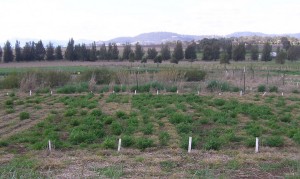 |
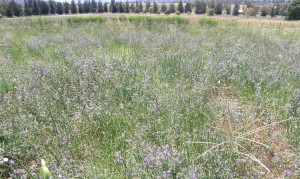 |
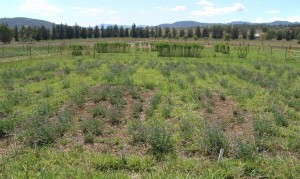 |
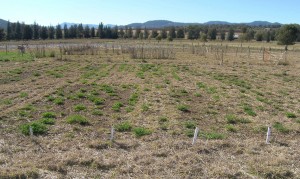 |
| Figure 2. Lucerne and digit grass mixtures experiment in early spring 2010 (top left), summer 2011 (top right), autumn 2011 (bottom left) and winter 2011 (bottom right). | |
Sowing time of year for pure swards
Lucerne sown in autumn had higher seedling densities than when sown in spring (39 vs 4 plants/m2). This resulted in lower plant frequencies and herbage mass (Figure 3, Table 3). While lucerne can be sown in spring on the North-West Slopes, it is commonly under irrigation. There is a high risk of failure in dryland sowings due to high temperatures and variable summer rainfall that often occurs in high intensity storms.
Digit grass sown in autumn did not emerge until September and had a seedling density of 6 plants/m2 while Digit grass sown in spring (November) had a seedling density of 26 plants/m2. Importantly, the winter that this experiment was established had below average rainfall, which prevented seed losses due to microbial activity. Crowns of individual plants grew to the extent that plant frequencies for both treatments were similar in November 2010 (Table 3). Individual Digit grass plant crowns can grow large (Figure 4) when plant densities are low resulting in high plant frequency, similar to swards with higher plant populations. The disadvantage is that large crowns tend to be raised forming ‘humps’ and there is a tendency for the plants to produce more stem compared with swards that have high plant densities.
| Table 3. Plant frequency (%) of pure swards in April 2010, November 2010 and May 2011, and herbage mass (t DM/ha) for the period July 2010–June 2011 and since sowing. | |||||
| Treatment | Plant frequency April 2010 (%) | Plant frequency November 2010 (%) | Plant frequency May 2011 (%) | Herbage mass 2010-11(t DM/ha) | Total herbage mass(t DM/ha) |
| Lucerne sown in different seasons | |||||
| Autumn sowing | 46 | 24 | 21 | 18.6 | 65.0 |
| Spring sowing | 3 | 4 | 4 | 5.0 | 15.4 |
| Digit grass sown in different seasons | |||||
| Autumn sowing | 38 | 55 | 41 | 15.1 | 35.3 |
| Spring sowing | 57 | 53 | 49 | 12.3 | 28.9 |
Sowing time of year for a lucerne-grass mix
Lucerne sown in autumn established well with 30-34 plants/m2, but lucerne sown in spring was very poor with 3-4 plants/m2. Digit grass sown together with lucerne in autumn established in September but in low plant numbers (12 plants/m2) and only in sections of the plot where there was no lucerne. Lucerne and digit grass sown together in spring established with low lucerne density (11 plants/m2) and moderate grass density (24 plants/m2). However, when digit grass was sown in spring (November), adjacent to autumn sown lucerne, the grass established (15 plants/m2) only where there was no lucerne. By spring when soil temperatures are sufficient for digit grass to germinate, lucerne was actively growing and produced a full canopy within about four weeks of grazing and by November most of the plant available soil water had been used (Figure 5).
To overcome this competition, the grass and lucerne may need to be separated by more than sowing in alternate rows, for example alternate strips one metre or more wide. Also, autumn sowing of tropical perennial grasses is not recommended because up to 100% of tropical grass seed sown in autumn can be lost during an ‘average’ winter due to microbial activity. Establishment of a lucerne and tropical grass mixture can be improved by sowing the tropical grass in spring and the lucerne in the following autumn.
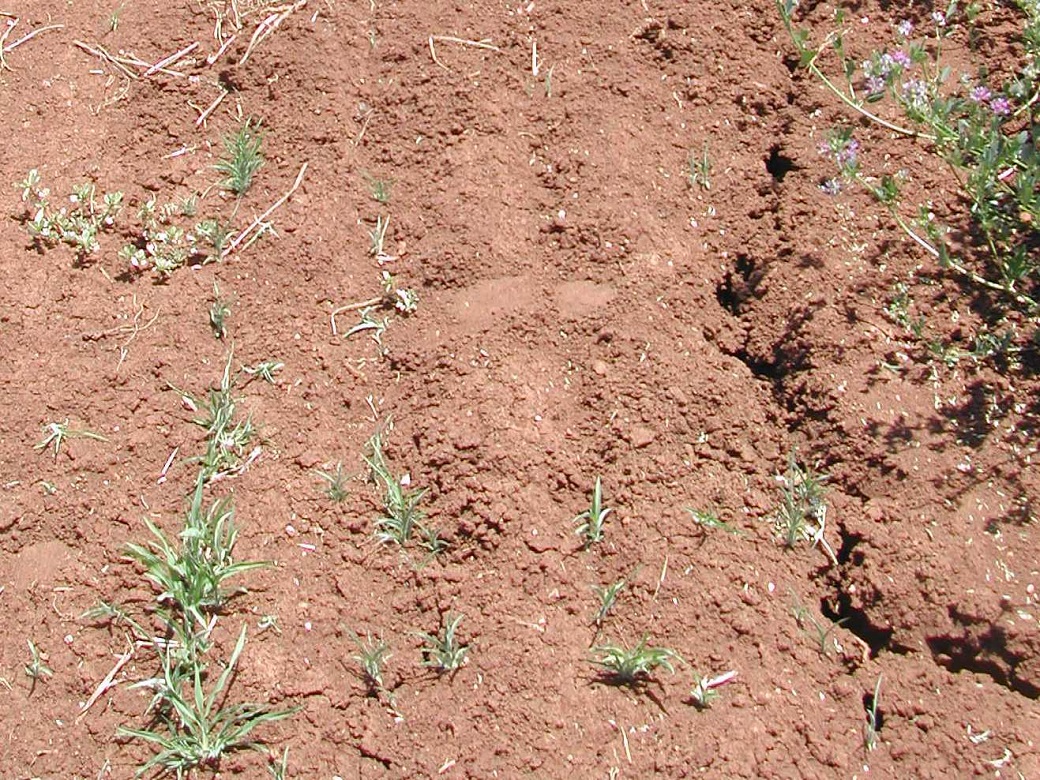
Pasture persistence – lucerne maintained frequency in a mixture
In pure swards, Premier digit grass and Kasbah cocksfoot persisted and the size of plant crowns increased, but cocksfoot tended to cycle through higher values in spring and lower values in autumn, reflecting dormancy though summer (Figure 6). Lucerne was persistent as a pure sward over the three years.
In mixtures, lucerne either maintained (with digit grass) or improved (with cocksfoot) frequency over the three years (Figure 1). Lucerne was more frequent (~40%) when grown with cocksfoot than with digit grass (~20%). Digit grass steadily increased frequency (from 40 to ~80%) when grown with lucerne, while cocksfoot strongly cycled through higher frequencies in spring and low values in autumn.
|
|
Mixtures produced similar herbage mass to pure lucerne
Averaged over three years, pure swards of lucerne grew significantly more herbage mass (17.6 t DM/ha) than did pure swards of digit grass (12.2 t DM/ha) or cocksfoot (10.1 t DM/ha, Table 4). Production in mixes was slightly lower compared with lucerne but not significantly so. Over three years, annual production from lucerne and digit grass averaged 15.2 t DM/ha and lucerne and cocksfoot averaged 16.2 t DM/ha, with production being elevated by increasing proportion of lucerne in the latter mixture. Lucerne-grass mixtures achieved production advantages over pure grass swards of 3 or 6 t DM/ha per year for the tropical or temperate grasses, respectively.
Lucerne provided a greater proportion of herbage in mixtures with cocksfoot (average 75% of dry matter) compared with mixtures with digit grass (average 57%) and lucerne provided an increasing proportion of production as the swards aged (e.g. from 69 to 81% for cocksfoot mixture and from 54 to 61% for digit grass mixture). This was accentuated during summer when Kasbah was dormant (Figure 7, Figure 8). Seasonal conditions in spring 2010, and early summer in both 2010-11 and 2011-12 were cool and wet and this favoured the dominance of lucerne within mixtures at those times (Figure 7, Figure 8).
Table 4. Total herbage mass (kg DM/ha) per growing season in 2009-10, 2010-11 and 2011-12 and proportion of legume (%).
| 2009-10 | 2010-11 | 2011-12 | ||||
| Treatment | t DM/ha | % legume | t DM/ha | % legume | t DM/ha | % legume |
| Venus lucerne | 17.3 | 100 | 19.6 | 100 | 15.8 | 97 |
| Premier digit | 13.6 | – | 14.2 | – | 9.0 | – |
| Premier digit + Venus lucerne | 16.5 | 54 | 17.2 | 56 | 12.0 | 61 |
| Kasbah cocksfoot | 7.3 | – | 13.3 | – | 9.5 | – |
| Kasbah cocksfoot + Venus lucerne | 13.2 | 69 | 20.1 | 75 | 15.3 | 81 |
The herbage production of the mixtures highlights the potential of lucerne-grass mixtures to increase production compared with a pure grass sward over the autumn-winter-spring period for the tropical grass mix, and over the spring-summer-autumn period for the temperate grass mix. The mixes are better able to take advantage of rainfall in seasons that it falls. However, the dominance of lucerne in mixture with Kasbah cocksfoot suggests that this mixture is not a strong option for North West Slopes of NSW, but may be suitable in regions with winter dominant rainfall.
|
|
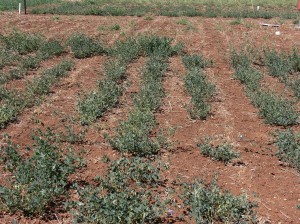 |
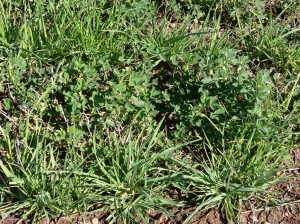 |
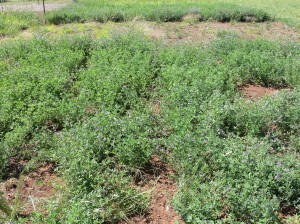 |
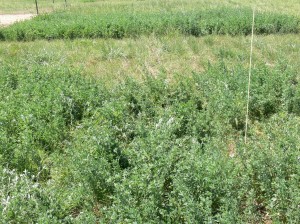 |
|
Figure 8. Lucerne and Kasbah cocksfoot mixtures in autumn, winter, spring and summer (clockwise from top left) demonstrating the dominance of lucerne at most times. |
|
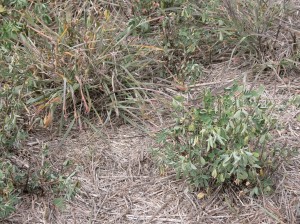 |
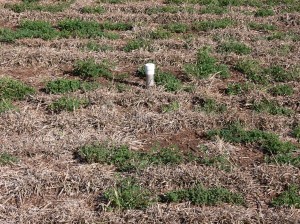 |
|
|
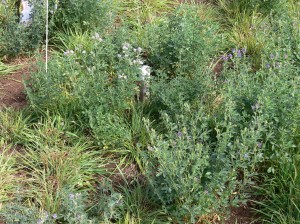 |
|
Figure 9. Lucerne and Premier digit mixtures in autumn, winter, spring and summer (clockwise from top left) demonstrating water stress in autumn, low growth in winter and strong growth through the warm season. |
|
Lucerne-grass mixes have similar water use efficiency to pure lucerne stands
Measures of stored soil water showed an annual pattern of drying the soil profile during the spring-summer-autumn period with some replenishment during the winter season (Figure 10). Premier digit grass recorded the driest profile in May 2010 but Kasbah cocksfoot tended to have a wetter profile compared with digit. Lucerne tended to have lower values of soil water throughout the experiment, apart from the late autumn 2010, when digit achieved its maximum drying. In latter seasons, values of soil water for both mixtures of lucerne-digit grass or lucerne-cocksfoot tended to mimic that of pure lucerne (Figure 10) demonstrating that lucerne was likely driving water use in the mixtures, regardless of the grass.
|
|
For total herbage production in each of the three growing seasons, water use efficiency (WUE) was generally higher in the first full year of production as soil water and nutrients were likely less limiting compared with latter years. Mixtures had higher WUE than the pure grasses and, in two of the three years, pure lucerne had the maximum WUE. However, differences in WUE between lucerne and the best performing mix in the first and third years were not significant (Table 5).
Table 5. Water use efficiency (kg DM/ha.mm) for the 2009-10 to 2011-12 growing seasons.
| Treatment | 2009-10 | 2010-11 | 2011-12 |
| Venus lucerne | 21.6 | 13.3 | 21.3 |
| Premier digit | 19.2 | 12.5 | 12.8 |
| Premier digit + Venus lucerne | 21.5 | 12.1 | 15.4 |
| Kasbah cocksfoot | 9.6 | 13.8 | 13.6 |
| Kasbah cocksfoot + Venus lucerne | 16.2 | 24.4 | 20.0 |
Ground cover – grass best but lucerne-grass not far behind
Ground cover in pure lucerne swards was only occasionally above the minimum ground cover benchmark of 70%. It was slow to reach the benchmark and variable over seasons (Figure 11). In contrast, pure digit grass achieved close to complete groundcover quickly and, excepting the first autumn/winter, maintained it for the remainder of the three years. Ground cover in pure cocksfoot increased over time and generally exceeded the 70% benchmark in the latter half of the experiment (Figure 11).
By the end of the first warm season, digit grass had achieved greater ground cover (98%) compared with lucerne (59%), but a mixture of the two achieved 82%, demonstrating its benefit in the establishment period (Figure 11). The mixture of lucerne and digit has maintained higher ground cover compared with pure lucerne and has been at or above the 70% benchmark since June 2010 (Figure 11)
Cocksfoot attained high ground cover (>70%) through winter and spring, but values declined through summer to be as low as 25% by late autumn. The mixture of cocksfoot and lucerne achieved ground cover levels that were higher than pure lucerne, but values in each autumn declined below the 70% benchmark (Figure 11).
These ground cover data show that to maintain ground cover above the 70% threshold, the lucerne-tropical grass mixture is preferable to a lucerne-temperate grass mixture.
|
|
Lucerne-digit grass mixes controlled both surface runoff and erosion
Lucerne generated much higher rates of runoff and more quickly than the mixtures in either season (Figure 12). These data clearly show that growing lucerne with Premier digit achieved runoff control in both spring and autumn, but when growing with Kasbah cocksfoot, unacceptable rates of runoff were observed in autumn (Figure 12) when Kasbah was still dormant and ground cover had declined (Figure 11).
Analyses of runoff water showed that much higher soil loss occurred from pure lucerne compared with lucerne-grass mixtures (Figure 13). For spring simulations, soil loss from the lucerne-grass mixtures was just 30% of that from lucerne alone. For autumn simulations, soil loss from the mixtures was 30-50% of that from lucerne alone.
These data clearly show that lucerne-grass mixtures can substantially reduce runoff rate and eroded sediment compared with lucerne, particularly in spring, which is the beginning of the storm season. The lucerne-grass mixture containing Premier digit appears to offer greater protection than does the mixture with Kasbah cocksfoot.
Crunching the numbers
Establishment costs for lucerne-grass mixtures will vary with species and varieties selected. It is important to match the species selected with soil type and position in the landscape. Examples of budgets for legumes and tropical grasses are provided here. A benefit-cost and payback period for investments in pastures can also be calculated using the EverGraze Pasture Improvement Calculator.
When making decisions on pasture improvement, planning must also go into utilising the additional feed; ask yourself ‘Will I have enough livestock to utilise the additional feed?’ Infrastructure planning is also necessary, additional fencing and watering points may be required to adequately use the additional feed and manage increased stock numbers.
Split sowings of tropical grasses with lucerne will not only incur another pass with sowing equipment but might also require herbicide for annual weeds before sowing lucerne.
Forage production was significantly increased by the combination of lucerne and a perennial grass over the grass grown alone and production from the mixture was spread across the year so livestock could access green feed and take advantage of rainfall at different times of the year. The mixture, being a combination of grass and lucerne, would alleviate risk of bloat in cattle for most of the year, thereby generating cost savings associated with use of bloat capsules. Further, long-term modelling of a ewe-lamb livestock enterprise on a range of pastures indicated that pure lucerne pasture least met animal requirements across a 100 year period and so reinforces the benefit obtained by growing lucerne in mixture with grass.
This research did not measure the contribution of the lucerne to nitrogen production; however, it is the subject of new research. It was assumed the lucerne did make some contribution to the nitrogen balance of the pasture.
On-farm experience
There have been a range of successes when lucerne and tropical grasses have been sown together commercially. They are usually sown together in spring, so this increases the risk of failure, unless the season goes very well. Seedling lucerne fails to establish when seasonal conditions become too hot for it. This is why paddocks sown with a mixture of lucerne and tropical grass in spring, have been variable in establishment and often resulted in low lucerne plant density.
Annual temperate legumes, particularly subterranean clover, have been used in the past also with variable success. This is problematic as autumn is when soil is driest under tropical grasses and variable rainfall prevents annual establishment of the legume and early dry springs also reduce adequate seed set. There are a number of producer’s trialling a range of hard seeded legumes to buffer against dry autumns and springs. Ongoing research at Tamworth Agricultural Institute is investigating the role of tropical legumes in mixes with tropical grasses.
Maintaining a legume in the pasture system for nitrogen production is an ongoing challenge.
Putting the research into practice
Lucerne is the most widely sown and adapted perennial legume in northern NSW, and when grown in pasture mixes with a perennial grass, the resulting pasture can be as productive as a pure lucerne stand, but also have the added benefits of maintaining ground cover to prevent runoff and erosion, and reduce potential for bloat in cattle because of the mixed intake. A lucerne-grass pasture mix may be a suitable option on your farm where you wish to benefit from the feed profile of lucerne, but with reduced natural resource management and livestock risks.
Establishment
To establish lucerne-grass pasture mixes in northern NSW:
- Ensure good weed control (both grass and broadleaf weeds) in seasons leading up to sowing a mixture is essential because of reduced herbicide control options once the mixture is sown.
- Avoid dryland spring sowing of lucerne as it is risky and poor establishment can result.
- Improve establishment by sowing the tropical grass in spring and the lucerne in the following autumn.
- Sow lucerne at least 1 kg/ha.
- Be prepared to manage for lucerne persistence using recommended grazing strategies or it may only be a short term legume.
The EverGraze principle put the Right Plant in the Right Place for the Right Purpose with the Right Management summarises the key considerations for selecting and establishing pastures. Each pasture species combination has specific soil fertility, moisture and landscape position requirements. These need to be considered together with the existing feed supply and demand profile to select an appropriate species for the right part of the landscape to fill the gaps. Key guidelines for putting the principle into action are provided in the EverGraze Exchange – Pastures for Place and Purpose. Guides to the place and purpose of individual species are provided on the Feedbase and pasture species page.
The MLA Feed Demand Calculator can be used to determine your existing feed supply/demand profile and identify the potential benefit of making changes to the feedbase, stocking rate or calving/lambing time.
Once you’ve selected the pasture species, the EverGraze Pasture Improvement Calculator can be used to determine the cost of establishment and the potential return. It’s important to consider what other options might meet the need, such as using supplements combined with improving the quality of existing native pastures. The EverGraze guide to assessing the costs and benefits of pasture establishment provides further details on economic analysis, including consideration of the intangible costs and benefits.
The NSW DPI Eight steps for pasture establishment (for temperate perennials), and the Tropical perennial grasses guides provide information on successful methods of establishing pastures.
Management
On-going research is currently taking place in northern NSW to examine best grazing management of lucerne-grass pasture mixes. However, rotational grazing is essential for productivity and longevity of lucerne and so management of a lucerne-grass mix should reflect this. Interactions between stocking rate, seasonal conditions, and stored soil water reserves will determine best grazing management.
What it all means
On the North West Slopes of NSW, pastures of lucerne-grass mixture offer significant environmental benefits over pure swards of lucerne and significant production benefits over pure swards of grass. For both temperate (cocksfoot, tall fescue) and tropical (digit) grasses in mixture with lucerne, there are negligible yield penalties and a better spread of production throughout the year. Lucerne is likely to persist well in the mixture and contribute to higher quality forage and high water use efficiency of the mixture. Lucerne-grass mixtures, particularly with a tropical grass, are likely to maintain ground cover above benchmarks and so limit erosion.
Acknowledgements
EverGraze is a Future Farm Industries CRC research and delivery partnership. The Tamworth EverGraze Proof Site team was led by Dr Sean Murphy (2010-2013) and Dr Greg Lodge (2007-2009) at the Department of Primary Industries, Tamworth NSW. An enthusiastic Regional Advisory Group consisting of farmers, consultants, extension officers and Catchment Management Authority staff provided significant input to the direction, management and interpretation of outcomes from the experiments to make them relevant to farmers.
Authors and contributors
Dr Sean Murphy, Department of Primary Industries, Tamworth, NSW
Lester McCormick, Department of Primary Industries, Tamworth, NSW
Dr Suzanne Boschma, Department of Primary Industries, Tamworth, NSW
Further Information
- EverGraze Action – Growing and using lucerne
- Primefact (NSW DPI) – Cocksfoot
- FFI CRC Tropical Perennial Grasses Guide for NSW
- Tropical grass establishment budgets
- Lucerne and clover establishment budgets
- Primefact – Tropical perennial grass for northern inland NSW
- Boschma SP, Lodge GM, Harden S (2010) Seedling competition of lucerne in mixtures with temperate and tropical pasture species. Crop & Pasture Science 61, 411-419.


